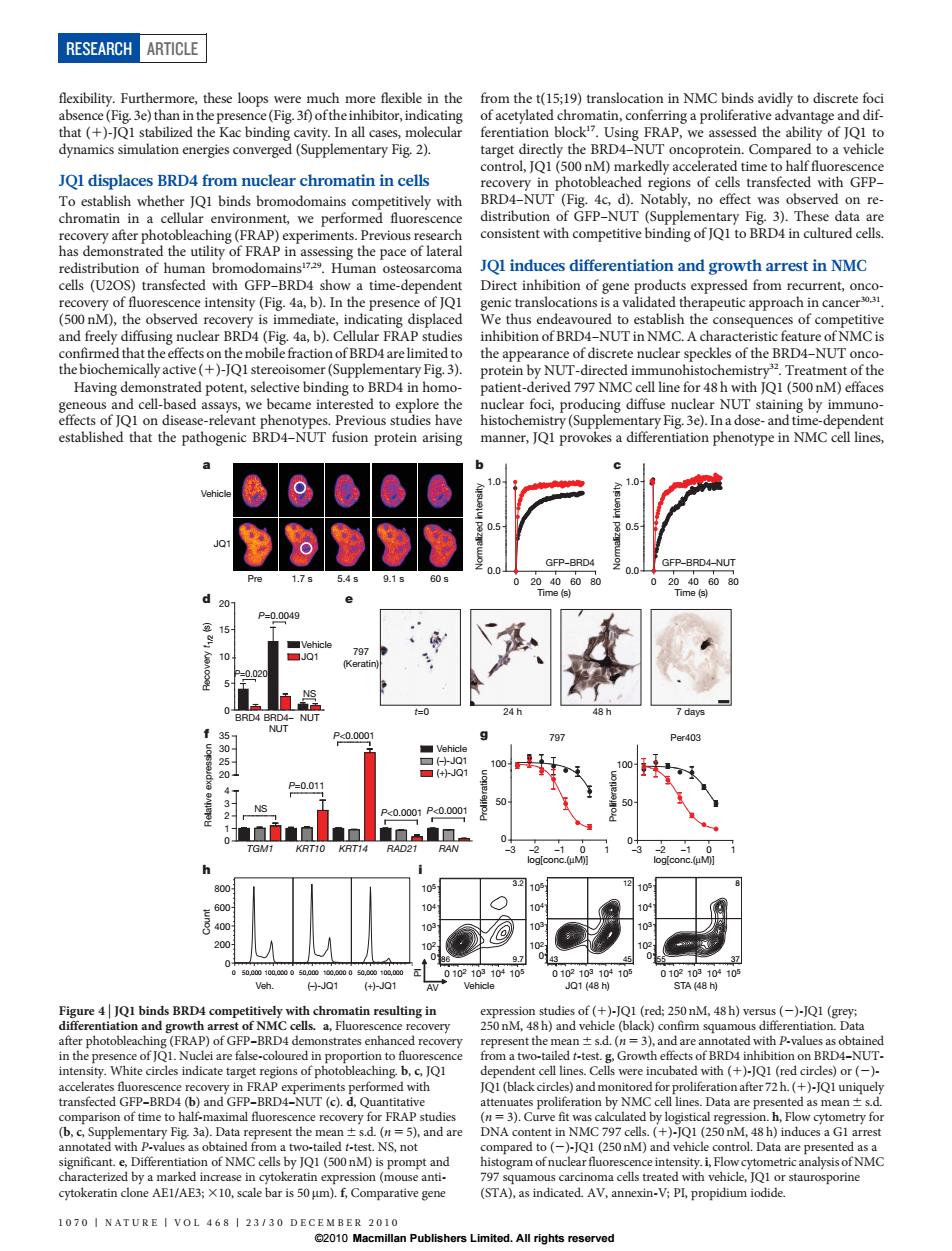正在加载图片...

RESEARCH ARTICLE flexibility.Furtherr from the t(15:19)translocation in NMC binds avidly to discrete foci T onc protein to a vehic JQl displaces BRD4 from nuclear chromatin in cells BRD4-N TGEP-NUT (S hing(FRAP) ious redistribution of human bro JQl induces differentiation and growth arrest in NMC cells (U2 ow a tim M). the observe o es ons bile fraction of BrD4are of discrete nuclea ckles of the BRD4-NUT o hemically active 1g r48 d to exp the foci,pro NU g by immu established that the path fusion protein arising manner,JQl pro a differentiation type in NMC cell lines 89℃ 001 P0.01 .0001P<0.0001 0 911010 aeO1bn杰BRD photob re pre A y of NMC cells by Q (50M 1070I NATURE I VOL 468 1 23/30 DECEMBE 2010 ⊥.All rights reserved flexibility. Furthermore, these loops were much more flexible in the absence (Fig. 3e) than in the presence (Fig. 3f) of the inhibitor, indicating that (1)-JQ1 stabilized the Kac binding cavity. In all cases, molecular dynamics simulation energies converged (Supplementary Fig. 2). JQ1 displaces BRD4 from nuclear chromatin in cells To establish whether JQ1 binds bromodomains competitively with chromatin in a cellular environment, we performed fluorescence recovery after photobleaching (FRAP) experiments. Previous research has demonstrated the utility of FRAP in assessing the pace of lateral redistribution of human bromodomains17,29. Human osteosarcoma cells (U2OS) transfected with GFP–BRD4 show a time-dependent recovery of fluorescence intensity (Fig. 4a, b). In the presence of JQ1 (500 nM), the observed recovery is immediate, indicating displaced and freely diffusing nuclear BRD4 (Fig. 4a, b). Cellular FRAP studies confirmed that the effects on the mobilefraction of BRD4 are limited to the biochemically active (1)-JQ1 stereoisomer (Supplementary Fig. 3). Having demonstrated potent, selective binding to BRD4 in homogeneous and cell-based assays, we became interested to explore the effects of JQ1 on disease-relevant phenotypes. Previous studies have established that the pathogenic BRD4–NUT fusion protein arising from the t(15;19) translocation in NMC binds avidly to discrete foci of acetylated chromatin, conferring a proliferative advantage and differentiation block17. Using FRAP, we assessed the ability of JQ1 to target directly the BRD4–NUT oncoprotein. Compared to a vehicle control, JQ1 (500 nM) markedly accelerated time to half fluorescence recovery in photobleached regions of cells transfected with GFP– BRD4–NUT (Fig. 4c, d). Notably, no effect was observed on redistribution of GFP–NUT (Supplementary Fig. 3). These data are consistent with competitive binding of JQ1 to BRD4 in cultured cells. JQ1 induces differentiation and growth arrest in NMC Direct inhibition of gene products expressed from recurrent, oncogenic translocations is a validated therapeutic approach in cancer30,31. We thus endeavoured to establish the consequences of competitive inhibition of BRD4–NUT in NMC. A characteristic feature of NMC is the appearance of discrete nuclear speckles of the BRD4–NUT oncoprotein by NUT-directed immunohistochemistry32. Treatment of the patient-derived 797 NMC cell line for 48 h with JQ1 (500 nM) effaces nuclear foci, producing diffuse nuclear NUT staining by immunohistochemistry (Supplementary Fig. 3e). In a dose- and time-dependent manner, JQ1 provokes a differentiation phenotype in NMC cell lines, Vehicle JQ1 Pre 1.7 s 5.4 s 9.1 s 60 s 0 20 40 60 80 0.0 0.5 1.0 Time (s) Normalized intensity 0 20 40 60 80 0.0 0.5 1.0 Time (s) Normalized intensity GFP–BRD4 GFP–BRD4–NUT a b c 0 1 2 3 4 20 25 30 35 TGM1 KRT10 KRT14 RAD21 RAN Relative expression P=0.011 NS P<0.0001 P<0.0001 P<0.0001 797 (Keratin) t=0 24 h 48 h 7 days Vehicle (+)-JQ1 (–)-JQ1 d f g P=0.020 P=0.0049 NS BRD4 NUT 0 5 10 15 20 Vehicle JQ1 Recovery t1/2 (s) BRD4– NUT e 797 –3 –2 –1 0 1 0 50 100 log[conc.(μM)] –3 –2 –1 0 1 log[conc.(μM)] Proliferation Per403 JQ1 (48 h) 12 43 45 STA (48 h) 8 55 37 Count 0 800 600 200 400 0 100,000 50,000 0 100,000 50,000 0 100,000 50,000 Veh. (–)-JQ1 (+)-JQ1 105 0 104 103 102 105 104 103 102 105 0 104 103 102 105 0 104 103 102 0 105 104 103 102 0 105 104 103 102 0 Vehicle 3.2 86 9.7 AV PI h i 0 50 100 Proliferation Figure 4 | JQ1 binds BRD4 competitively with chromatin resulting in differentiation and growth arrest of NMC cells. a, Fluorescence recovery after photobleaching (FRAP) of GFP–BRD4 demonstrates enhanced recovery in the presence of JQ1. Nuclei are false-coloured in proportion to fluorescence intensity. White circles indicate target regions of photobleaching. b, c, JQ1 accelerates fluorescence recovery in FRAP experiments performed with transfected GFP–BRD4 (b) and GFP–BRD4–NUT (c). d, Quantitative comparison of time to half-maximal fluorescence recovery for FRAP studies (b, c, Supplementary Fig. 3a). Data represent the mean 6 s.d. (n 5 5), and are annotated with P-values as obtained from a two-tailed t-test. NS, not significant. e, Differentiation of NMC cells by JQ1 (500 nM) is prompt and characterized by a marked increase in cytokeratin expression (mouse anticytokeratin clone AE1/AE3; 310, scale bar is 50 mm). f, Comparative gene expression studies of (1)-JQ1 (red; 250 nM, 48 h) versus (2)-JQ1 (grey; 250 nM, 48 h) and vehicle (black) confirm squamous differentiation. Data represent the mean 6 s.d. (n 5 3), and are annotated with P-values as obtained from a two-tailed t-test. g, Growth effects of BRD4 inhibition on BRD4–NUTdependent cell lines. Cells were incubated with (1)-JQ1 (red circles) or (2)- JQ1 (black circles) and monitored for proliferation after 72 h. (1)-JQ1 uniquely attenuates proliferation by NMC cell lines. Data are presented as mean 6 s.d. (n 5 3). Curve fit was calculated by logistical regression. h, Flow cytometry for DNA content in NMC 797 cells. (1)-JQ1 (250 nM, 48 h) induces a G1 arrest compared to (2)-JQ1 (250 nM) and vehicle control. Data are presented as a histogram of nuclear fluorescence intensity. i, Flow cytometric analysis of NMC 797 squamous carcinoma cells treated with vehicle, JQ1 or staurosporine (STA), as indicated. AV, annexin-V; PI, propidium iodide. RESEARCH ARTICLE 1070 | NATURE | VOL 468 | 23/30 DECEMBER 2010 ©2010 Macmillan Publishers Limited. All rights reserved